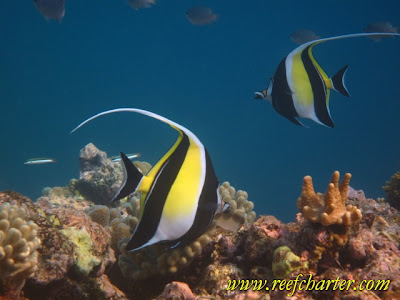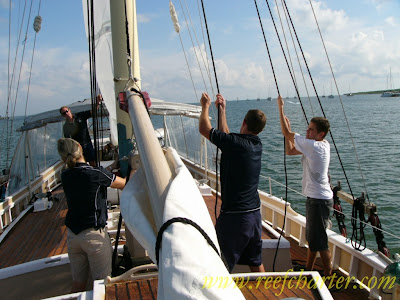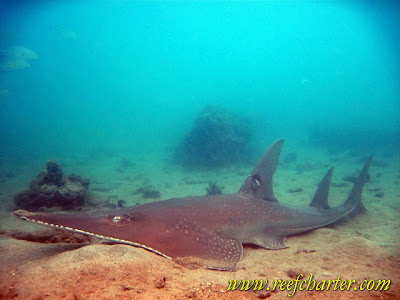Very popular with scuba divers on our trips to the outer Great Barrier Reef, barracuda are an impressive sight on the reef. The fearsome looking barracuda has a reputation for being and aggressive fish but it is mostly undeserved. They really use their incredible speed to shock and attack its victims of smaller fish. They do not see humans as a meal or as a threat unless actively provoked. They have been known to get aggressive where potential food is involved, another good reason not to feed the fish or support operators that feed fish.
They are often seen in large groups in the early morning or late afternoon hanging around at the back of the reefs. What are groups of barracuda called? Batteries. The can grow to about 1.6 metres or just over 5ft, the guys in the photo above are just over a metre each. They have a large swim bladder (gas filled bladder) they use to control their buoyancy in the water. This allows them to hover perfectly for long periods of time with very little use of energy.
Month: March 2010
Moorish Idols – Species of the Reef
The Moorish Idol is a common fish around the reefs and prefer to swim around the top of the corals feeding on sponges, and small invertebrates. Our snorkellers and divers often encounter the idol as it grazes amongst the coral gardens of the Great Barrier Reef.
It is easily recognized as it has a thin body with a round shape. This is highlighted but very distinctive yellow and black bands with white contrasts that run vertically up the body. During the night these colours actually become more dull and sink to the base of the reef for protection from predators. They also have several long dorsal spines that extend from the main part of the fin to flow over the back of the idol.
These fish are very popular with aquarium owners because of their bright colours and trailing dorsal fin. However they are notoriously difficult to keep alive, they can be very picky eaters and require large tanks as well as good water quality.
Moorish Idols mate for life. The release their eggs to drift where they drift until their larvae reaches about 7cm or 3in, when they as juveniles start to swim on their own and develop into mature adults.
February Customer Satisfaction Results
Every month we publish our customer survey results and this month is no exception. These surveys as our guests know are compiled independently and published every month by James Cook University and aggregated from various operators every quarter. Why do we publicly expose these survey results? We think that you should have all the information available to you before making your decision on the best way to see the reef. I would also recommend that you ask other operators for their customer feedback or independent survey results before making your choice. We understand that seeing the Great Barrier Reef for many people is a lifelong dream and for many other a once in a lifetime experience, there making sure you have something to remember fondly for years to come.
Who Came on Our Trips
44% from N.America and 37.5% from Europe ,
28.5% professionals,
50% travelling with their parner,
100% first time visitors to TNQ, 94% first time reef visitors.
What They Thought
Reef met expectations: 73.3% very much & 26.7% yes
Trip met expectations: 60% very much & 40% yes
Received value for money: 94% yes
Would recommend the trip: 100% yes
Average satisfaction score: 8.88 /10
Shovelnose Ray – Species of the Reef
These rays are a great thrill when you get one that is remaining still enough for you to get a good look it. Our divers always remark and remember the encounter as one to remember for years to come.
There is no wondering how this fish got its name, its big wide flat head and the way it works its way across the sand clearly resemble a shovel. They are also known as the guitarfish. Looking like a cross between shark, ray and fish the shovelnose ray is something completely different.
The shovelnose ray eats small crustaceans and are therefore seen around the base of reefs and grassy sea beds. When not feeding they like other rays they tend to bury themselves in the sand. So when diving keeping a close eye out and paying close attention to your surroundings you may catch one of these guys chilling out in the sand. But stay away as they are timid creatures and will probably take off as soon as you approach, so just check them out from a distance.
The shovelnose ray gives birth to live young and often twins, yes two at a time. The young normally stay around the area of their birth until they mature and start to wander off and explore areas of their own. They can grow up to about 1.8m or 6ft and have about 65-70 rows of teeth.



